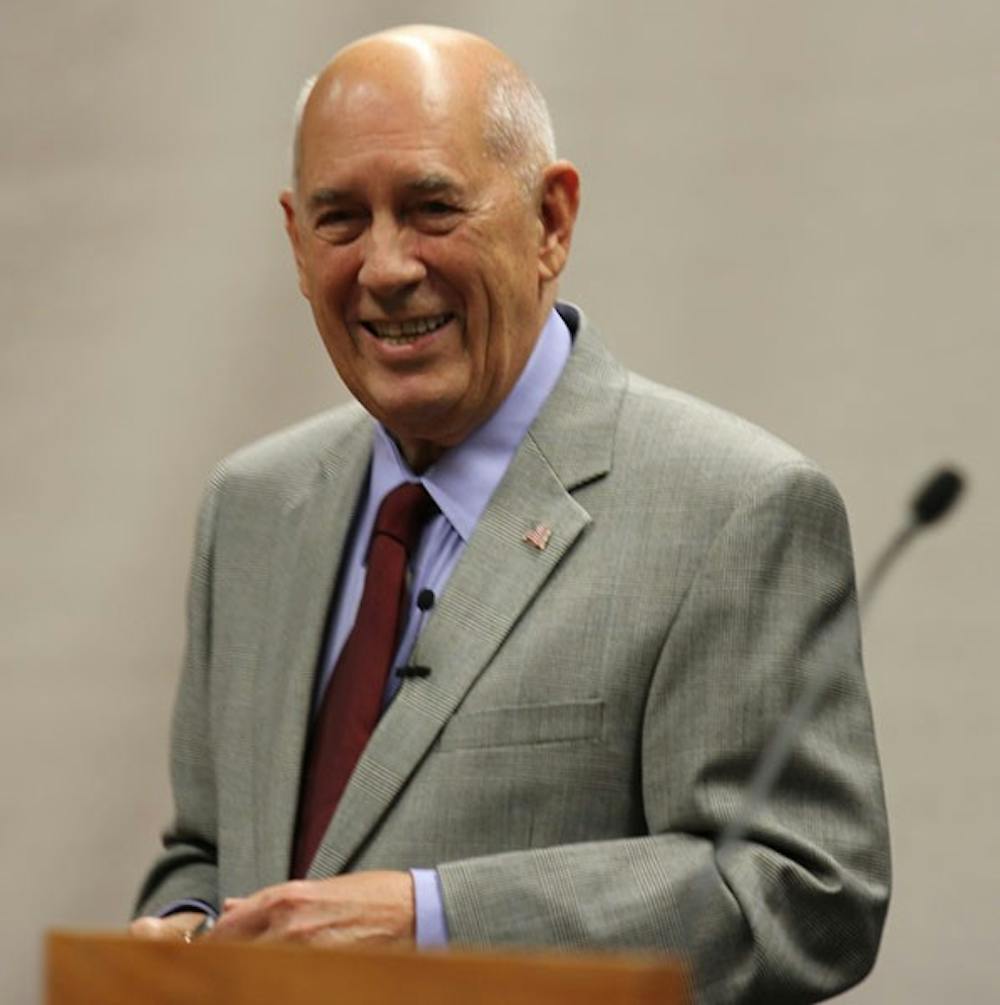 Bill Rasmussen addresses ASU students at the Arizona Ballroom in the Memorial Union on Thursday night. He told the story of founding ESPN and signed books. (Photo by Kyle Newman)
Bill Rasmussen addresses ASU students at the Arizona Ballroom in the Memorial Union on Thursday night. He told the story of founding ESPN and signed books. (Photo by Kyle Newman)ESPN co-founder Bill Rasmussen told the story of his entrepreneurial success and how his network has shaped the sports landscape to students and faculty at the Memorial Union on Thursday.
Prior to taking the podium, Rasmussen sat down with The State Press to talk about ESPN’s place in television history and offer advice for future generations of entrepreneurs.
;
The State Press: What was the vision you had for ESPN when it first went on the air in 1979?
Bill Rasmussen: The message we had back then is the same message we have today. We promise sports 24 hours a day for the fans. Sports back in those days only had about 1,400 hours of airtime between the big three networks. They only did about 25 football games each year, and that was it. We wanted to do as many different sports for as many different people as possible around the clock. That was the premise then and today on the back of each employee’s card. That mission statement is six words: To serve sports fans anytime, anywhere.
SP: After ESPN launched in 1979, was there a specific moment in which you realized that it would be successful, or was it a gradual realization that you had something special with ESPN?
BR: It was certainly a panic-driven process for the first seven months, but then we came to the basketball playoffs that today are March Madness.
Back then, it was just the NCAA championship. It was back during the 1979-80 season when there was only a 32-team field. We said to the NCAA that we’d show every game that the networks don’t do. We televised them all when they started the first round that Thursday, and we did the games live when we could, taping them when we couldn’t.
We ran some of those games four, five and six times for promotional purposes. All of a sudden, our subscriber base turned almost straight north. In one month, we picked up five and a half million households. To this day, I think that is the highest month of any single batch of subscribers to a station, ever.
SP: At what age did sports and athletics become important to you?
BR: Around the first grade. I played baseball and softball a lot. I could run and I could field pretty well. I played in my first organized grade when the eighth grade team at my school asked me as a fifth-grader to play with them. I was 50 years old when I was playing in my last league. I umpired for 11 years as well.
SP: When did you realize that you wanted to pursue a career that included bringing the events of the sporting world to the viewing public?
BR: I remember when I was in high school in the late 1940s, there was a presentation by the announcers of the Chicago Cubs and the Chicago White Sox. The place was packed. I thought that if I couldn’t play ball professionally, I could still do something like what those announcers were doing. I was 30 years old when I got my first radio job.
SP: One of the impressive elements in the evolution of ESPN has been that in previous decades ESPN has managed to maintain its profitability and success even during times of economic downturn. Is there anything having to do with the business aspect of ESPN that you would contribute that resiliency too?
BR: We can attribute that to the fans. They make it work.
Every man and woman who we employ knows that they owe their jobs to the fans.
Sports lovers represent a huge demographic, and it’s the driving force behind what we do — we never ever lose sight of that fact.
;
Reach the reporter at mjgordo1@asu.edu




